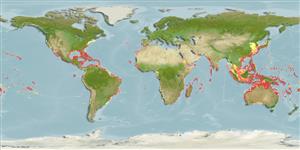Actinopterygii (strålfeniga fiskar) >
Perciformes (Perch-likes) >
Sphyraenidae (Barracudas)
Etymology: Sphyraena: Greek, sphyraina, -es = the name of a fish (Ref. 45335).
Miljö / Klimat / Range
Ekologi
; marina; brackvatten revassocierade; djupintervall 1 - 100 m (Ref. 6949), usually 3 - 30 m (Ref. 40849). Subtropical, preferred 27°C (Ref. 107945); 42°N - 35°S, 180°W - 180°E (Ref. 55300)
Indo-Pacific: Red Sea and east coast of Africa to Hawaii and the Marquesas and Tuamoto islands. Western Atlantic: Massachusetts (USA), Bermuda, and throughout the Caribbean Sea to Brazil (Ref. 9626). Eastern Atlantic: Sierra Leone, Côte d'Ivoire, Togo, Nigeria, Senegal (Ref. 6949), Mauritania (Ref. 5377), St. Paul's Rocks (Ref. 13121), and São Tomé Island (Ref. 34088).
Length at first maturity / Size / Vikt / Age
Maturity: Lm 66.0, range 58 - ? cm
Max length : 200 cm TL hane/ej könsbestämd; (Ref. 7251); common length : 140 cm TL hane/ej könsbestämd; (Ref. 3692); publicerad maxvikt: 50.0 kg (Ref. 6949)
Taggstrålar i ryggfenan (totalt): 6; Mjukstrålar i ryggfenan (totalt): 9; Taggstrålar i analfenan 1; Mjukstrålar i analfenan: 10. Distinguished by the double emarginate tail fin with pale tips on each lobe, and (usually) the presence of a few scattered black blotches on the lower sides (Ref. 1602). Top of head between eyes flat or concave; mouth large (Ref. 26938).
Found predominantly at or near the surface (Ref. 6949, 48637). Juvenile occurs among mangroves, estuaries and shallow sheltered inner reef areas; adult occurs in a wide range of habitats from murky inner harbors to open seas. Diurnal and solitary, but can also be found in small aggregations. Feeds on fishes, cephalopods and sometimes on shrimps (Ref. 9626, 48637). Sold fresh. Utilized also dried or salted (Ref. 9987). Although this species is ciguatoxic elsewhere throughout its range, it has not been reported to be poisonous in the eastern Atlantic (Ref. 6949, 48637). Rarely attacks humans, usually with one quick, fierce strike, which, although serious, is rarely fatal. The world's record on hook and line is a 5.5-ft. fish taken in the Bahamas that weighed 103 lbs. (Ref. 13442).
Daget, J., 1986. Sphyraenidae. p. 350-351. In J. Daget, J.-P. Gosse and D.F.E. Thys van den Audenaerde (eds.) Check-list of the freshwater fishes of Africa (CLOFFA). ISNB, Brussels; MRAC, Tervuren; and ORSTOM, Paris. Vol. 2. (Ref. 4339)
IUCN Red List Status (Ref. 115185)
CITES (Ref. 94142)
Not Evaluated
Threat to humans
Traumatogenic (Ref. 4690)
Human uses
Fiskeri: mindre kommeriell; sportfisk: ja; Akvarium: Offentliga akvarier
Verktyg
Special reports
Download XML
Internet-källor
